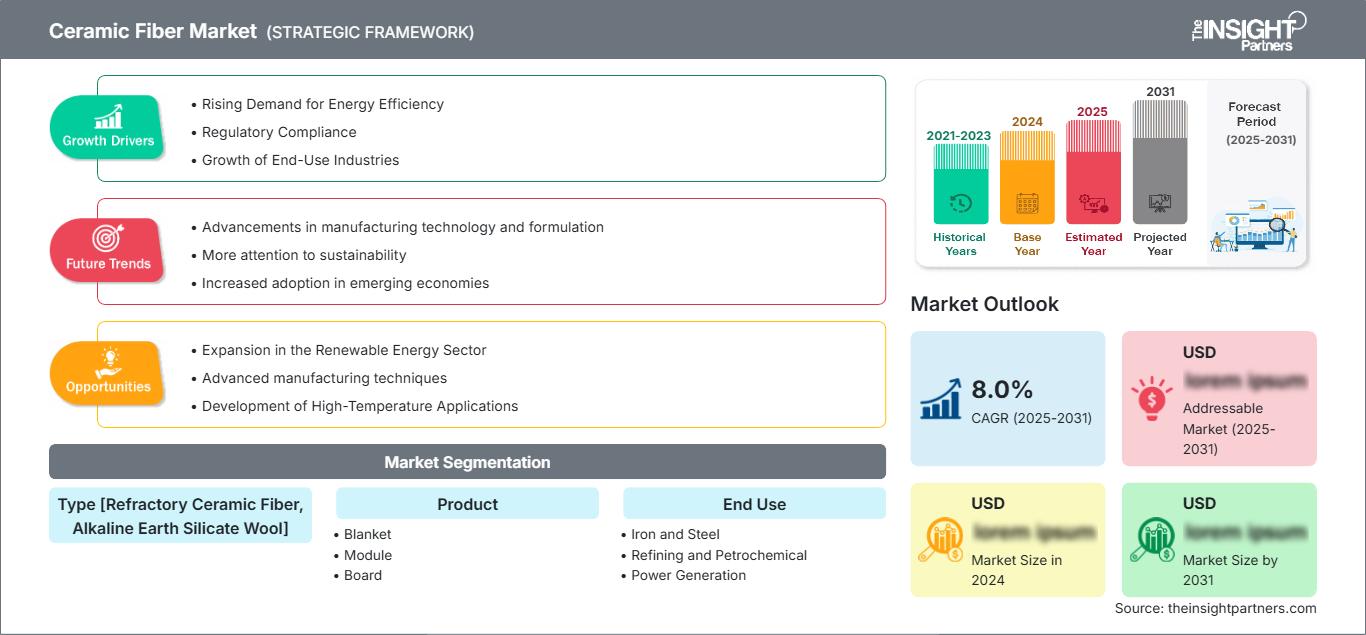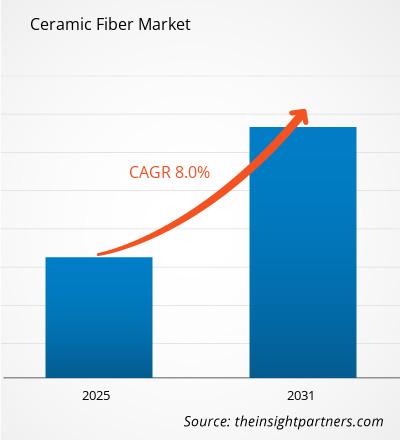预计到2031年,陶瓷纤维市场规模将达到31.2亿美元。预计2025年至2031年期间,该市场将以8.9%的复合年增长率增长。
陶瓷纤维市场按类型、产品和最终用途进行细分。按类型划分,市场分为耐火陶瓷纤维、碱土硅酸盐棉和其他类型。按产品划分,陶瓷纤维市场分为毯状、模块状、板材状、纸状和其他类型。按最终用途划分,市场分为钢铁、炼油和石化、发电、铝业和其他行业。报告涵盖五大区域:北美、欧洲、亚太、中东和非洲以及南美和中美洲,并重点关注各区域的主要国家。全球分析进一步细化到区域和主要国家层面。报告以美元为单位提供上述分析和细分市场的价值。
报告目的
The Insight Partners发布的《陶瓷纤维市场报告》旨在描述陶瓷纤维市场的现状和未来增长趋势,包括主要驱动因素、挑战和机遇。该报告将为各类商业利益相关者提供参考,例如:
- 技术提供商/制造商:了解不断变化的市场动态和潜在的增长机会,从而能够做出明智的战略决策。
- 投资者:对市场增长率、市场财务预测以及整个价值链中存在的机会进行全面的趋势分析。
- 监管机构:监管市场政策和执法活动,旨在最大限度地减少滥用行为,维护投资者信任和信心,维护市场的诚信和稳定。
陶瓷纤维市场细分类型 [耐火陶瓷纤维、碱土硅酸盐棉]
产品
- 毯子
- 模块
- 木板
- 纸]
最终用途
- 钢铁
- 炼油和石油化工
- 发电
- 铝]
地理
- 北美
- 欧洲
- 亚太
- 南美洲和中美洲
- 中东和非洲
您可以免费获得任何报告的定制服务,包括本报告的部分内容、国家/地区层面的分析、Excel 数据包,以及面向初创企业和高校的优惠折扣。
陶瓷纤维市场:战略洞察

-
获取本报告的主要市场趋势。这份免费样品将包含数据分析,内容涵盖市场趋势、估算和预测等。
陶瓷纤维市场增长驱动因素
- 能源效率需求日益增长:能源效率需求的不断增长显著提升了陶瓷纤维的作用,尤其是在隔热性能至关重要的行业。鉴于发电、制造和其他工业领域对能源成本的日益关注,陶瓷纤维作为减少热损失、降低能耗和提升系统性能的有效材料正被广泛认可。这些纤维具有优异的隔热性能,使用陶瓷纤维能够帮助各行业降低能源成本和碳排放。随着可持续发展目标的不断提高和对能源效率提升的追求,企业正将陶瓷纤维视为实现长期成本节约和环境效益的理想解决方案。
- 法规遵从性:日益严格的排放和环境法规迫使各行业使用陶瓷纤维等先进材料。这些材料不仅环保,还能满足法规对隔热性能和热量管理的更高要求。
- 终端用户行业的增长:航空航天、汽车和石化行业的进步是陶瓷纤维市场的重要增长驱动力之一。这些行业的蓬勃发展提高了对用于绝缘的耐高温材料的需求。
陶瓷纤维市场未来趋势
- 制造技术和配方方面的进步:先进陶瓷纤维的研发得益于制造技术和配方的进步。这些进步使得陶瓷纤维能够更好地承受严苛的高温环境,并延长材料的使用寿命。
- 更加注重可持续性:如今的生产工艺和材料都更加注重可持续性。企业现在更加关注可回收利用和环保材料,这与陶瓷纤维的特性相符。
- 新兴经济体应用日益广泛:由于工业增长、基础设施建设以及对能源效率日益增长的关注,陶瓷纤维在新兴经济体的应用正在迅速增长。随着这些经济体制造业能力的提升,尤其是在钢铁、水泥、汽车和能源等行业,对陶瓷纤维等高性能绝缘材料的需求激增。陶瓷纤维具有优异的耐热性、轻质和节能特性,使其适用于高温工业生产过程,从而帮助企业节约能源并提高效率。
陶瓷纤维市场机遇
- 可再生能源领域的扩张:可再生能源领域的增长大幅提升了对陶瓷纤维的需求,陶瓷纤维是该领域的主要材料之一,以其优异的耐热性和绝缘性能而闻名。随着风能、太阳能和地热能等可再生能源相关技术的不断发展,陶瓷纤维在节能设备绝缘领域的应用也日益广泛,例如涡轮叶片、太阳能电池板和地热发电厂等。陶瓷纤维即使在高温下也能保持良好的能源效率,这对于提升可再生能源系统的性能和延长其使用寿命至关重要。
- 先进制造技术:先进制造技术,例如增材制造,已成为陶瓷纤维的新兴途径,因为它们能够将陶瓷纤维融入真正创新的设计中,同时最大限度地提高性能并最大限度地减少浪费。
- 高温应用开发:这些行业对提高工作温度的兴趣日益浓厚,因此对耐高温定制陶瓷纤维的需求也随之增长。制造商有机会生产满足其关键需求的专用解决方案。
陶瓷纤维市场区域洞察
The Insight Partners 的分析师对预测期内影响陶瓷纤维市场的区域趋势和因素进行了详尽的阐述。本节还探讨了北美、欧洲、亚太、中东和非洲以及南美和中美洲等地区的陶瓷纤维市场细分和地域分布。
陶瓷纤维市场报告范围
| 报告属性 | 细节 |
|---|---|
| 2024年市场规模 | XX亿美元 |
| 到2031年市场规模 | 31.2亿美元 |
| 全球复合年增长率(2025-2031年) | 8.9% |
| 史料 | 2021-2023 |
| 预测期 | 2025-2031 |
| 涵盖部分 |
按类型 [耐火陶瓷纤维、碱土硅酸盐棉]按产品
|
| 覆盖地区和国家 |
北美
|
| 市场领导者和主要公司简介 |
|
陶瓷纤维市场参与者密度:了解其对业务动态的影响
陶瓷纤维市场正快速增长,这主要得益于终端用户需求的不断增长,而终端用户需求的增长又源于消费者偏好的转变、技术的进步以及消费者对产品优势认知的提高。随着需求的增长,企业不断拓展产品和服务,持续创新以满足消费者需求,并把握新兴趋势,这些都进一步推动了市场增长。

- 获取陶瓷纤维市场主要参与者概览
主要卖点
- 全面覆盖:该报告全面分析了陶瓷纤维市场的产品、服务、类型和最终用户,提供了全面的市场概况。
- 专家分析:该报告是根据行业专家和分析师的深入理解编制的。
- 最新信息:该报告涵盖了最新的信息和数据趋势,确保了其与业务的相关性。
- 定制选项:本报告可根据客户的具体需求进行定制,并能恰当地适应业务战略。
因此,这份关于陶瓷纤维市场的研究报告有助于深入了解和解读行业现状及增长前景。尽管其中可能存在一些合理的担忧,但总体而言,这份报告的优势远大于劣势。
- 历史分析(2 年)、基准年、预测(7 年)及复合年增长率
- PEST和SWOT分析
- 市场规模、价值/数量 - 全球、区域、国家
- 行业和竞争格局
- Excel 数据集
近期报告
相关报告
客户评价
购买理由
- 明智的决策
- 了解市场动态
- 竞争分析
- 客户洞察
- 市场预测
- 风险规避
- 战略规划
- 投资论证
- 识别新兴市场
- 优化营销策略
- 提升运营效率
- 顺应监管趋势






















 获取免费样品 - 陶瓷纤维市场
获取免费样品 - 陶瓷纤维市场